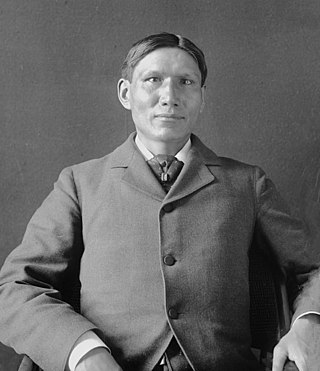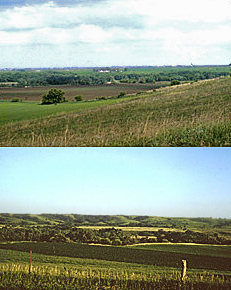The Missouria or Missouri are a Native American tribe that originated in the Great Lakes region of what is now the United States before European contact. The tribe belongs to the Chiwere division of the Siouan language family, together with the Ho-Chunk, Winnebago, Iowa, and Otoe.
The Hocągara (Ho-Chungara) or Hocąks (Ho-Chunks) are a Siouan-speaking Native American Nation originally from Wisconsin and northern Illinois. Due to forced emigration in the 19th century, they now constitute two individual tribes; the Ho-Chunk Nation of Wisconsin and the Winnebago Tribe of Nebraska. They are most closely related to the Chiwere peoples, and more distantly to the Dhegiha.

The Iowa, also known as Ioway, and the Bah-Kho-Je or Báxoje, are a Native American Siouan people. Today, they are enrolled in either of two federally recognized tribes, the Iowa Tribe of Oklahoma and the Iowa Tribe of Kansas and Nebraska.

The Otoe are a Native American people of the Midwestern United States. The Otoe language, Chiwere, is part of the Siouan family and closely related to that of the related Iowa, Missouria, and Ho-Chunk tribes.

Mahaska, or White Cloud, was a chief of the Native American Iowa tribe. His son, also named Mahaska, was better known as Francis White Cloud.

The Iowa Tribe of Oklahoma is one of two federally recognized tribes for the Iowa people. The other is the Iowa Tribe of Kansas and Nebraska. Traditionally Iowas spoke the Chiwere language, part of the Siouan language family. Their own name for their tribe is Bahkhoje, meaning, "grey snow," a term inspired by the tribe's traditional winter lodges covered with snow, stained grey from hearth fires.

The Meskwaki, also known by the European exonyms Fox Indians or the Fox, are a Native American people. They have been closely linked to the Sauk people of the same language family. In the Meskwaki language, the Meskwaki call themselves Meshkwahkihaki, which means "the Red-Earths", related to their creation story.
The Otoe–Missouria Tribe of Indians is a federally recognized tribe, located in Oklahoma. The tribe is made up of Otoe and Missouria peoples. Their language, the Chiwere language, is part of the Siouan language family.
Chiwere is a Siouan language originally spoken by the Missouria, Otoe, and Iowa peoples, who originated in the Great Lakes region but later moved throughout the Midwest and plains. The language is closely related to Ho-Chunk, also known as Winnebago.
Truman Washington Dailey, also known as Mashi Manyi and Sunge Hka, was the last native speaker of the Otoe-Missouria dialect of Chiwere (Baxoje-Jiwere-Nyut'achi), a Native American language. He was a member of the Otoe-Missouria Tribe of Indians.

The Dakota are a Native American tribe and First Nations band government in North America. They compose two of the three main subcultures of the Sioux people, and are typically divided into the Eastern Dakota and the Western Dakota.

The Blood Run Site is an archaeological site on the border of the US states of Iowa and South Dakota. The site was essentially populated for 8,500 years, within which earthworks structures were built by the Oneota Culture and occupied by descendant tribes such as the Ioway, Otoe, Missouri, and shared with Quapaw and later Kansa, Osage, and Omaha people. The site was so named on account of the iron-stained soil.

The archaeology of Iowa is the study of the buried remains of human culture within the U.S. state of Iowa from the earliest prehistoric through the late historic periods. When the American Indians first arrived in what is now Iowa more than 13,000 years ago, they were hunters and gatherers living in a Pleistocene glacial landscape. By the time European explorers visited Iowa, American Indians were largely settled farmers with complex economic, social, and political systems. This transformation happened gradually. During the Archaic period American Indians adapted to local environments and ecosystems, slowly becoming more sedentary as populations increased. More than 3,000 years ago, during the Late Archaic period, American Indians in Iowa began utilizing domesticated plants. The subsequent Woodland period saw an increase on the reliance on agriculture and social complexity, with increased use of mounds, ceramics, and specialized subsistence. During the Late Prehistoric period increased use of maize and social changes led to social flourishing and nucleated settlements. The arrival of European trade goods and diseases in the Protohistoric period led to dramatic population shifts and economic and social upheaval, with the arrival of new tribes and early European explorers and traders. During the Historical period European traders and American Indians in Iowa gave way to American settlers and Iowa was transformed into an agricultural state.
Ocooch Mountains are a place name for the Western Upland area of Wisconsin also known as the Driftless Region, meaning un-glaciated, lacking glacial drift or the Paleozoic Plateau, referring to a geologic era, Greek for "ancient life". The lack of glaciated terrain accounts for high hills, bluffs, and ridges. The Chippewa, Black, La Crosse, Kickapoo, Baraboo, Lemonweir, Pine, Wisconsin, Grant, Platte and Pecatonia rivers and their tributaries create deeply eroded valleys that contrast the nearby peaks. One dramatic example is Wildcat Mountain State Park. The Baraboo Range anchors the eastern edge where the Wisconsin River turns and runs through the area to the Mississippi River. The Baraboo Range is a monadnock in Sauk and Columbia Counties and a National Natural Landmark formed 1.6 billion years ago featuring Devil's Lake, an endorheic lake.
This timeline of South Dakota is a list of events in the history of South Dakota by year.
The fourth Treaty of Prairie du Chien was negotiated between the United States and the Sac and Meskwaki, the Mdewakanton, Wahpekute and Sisseton Sioux, Omaha, Ioway, Otoe and Missouria peoples. The treaty was signed on July 15, 1830, with William Clark and Willoughby Morgan representing the United States. Through additional negotiations conducted in St. Louis on October 13, 1830, Yankton Sioux and Santee Sioux agreed to abide by the 1830 Treaty of Prairie du Chien. The US government announced the treaty and its numerous adherents on February 24, 1831.
The Dhegihan migration and separation was the long journey on foot by the North American Indians in the ancient Hą́ke tribe. During the migration from present-day Illinois/Kentucky and as far as Nebraska, they gradually split up into five groups. Each became an independent and historic tribe. They are the Omaha, Ponca, Kaw or Kansa, Osage and Quapaw.

Mildred Mott Wedel was an American scholar of Great Plains archaeology and ethnohistory. She was one of the first professionally trained female archaeologists and was distinguished in her field. Many of her publications were about the Siouan people, and wrote several important articles on French exploration in the Central and Southern Plains.















